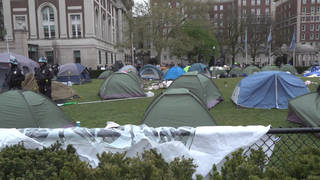
Related
Topics
Guests
- Smita Narulafaculty director of the International Human Rights Clinic at NYU’s School of Law. She is co-author of the report, “Nourishing Change: Fulfilling the Right to Food in the United States.”
As Republicans move to cut billions of dollars in funding for food stamps, a new report finds one in six Americans live in a household that cannot afford adequate food. In “Nourishing Change: Fulfilling the Right to Food in the United States,” the International Human Rights Clinic at New York University’s School of Law reports that of these 50 million people going hungry, nearly 17 million are children. Food insecurity has skyrocketed since the economic downturn, with an additional 14 million people classified as food insecure in 2011 than in 2007. The report comes as Congress is renegotiating the farm bill and proposing serious cuts to the Supplemental Nutrition Assistance Program (SNAP), formerly known as the Food Stamp Program. Millions of Americans currently rely on the program to feed themselves and their families. The report’s co-author, Smita Narula of the International Human Rights Clinic at NYU’s School of Law, joins us to discuss her findings and why she is calling on the U.S. government to ensure that all Americans have access to sufficient, nutritious food.
Transcript
JUAN GONZÁLEZ: We turn now to the silent crisis of hunger in America today. According to a new report, one in six Americans live in a household that cannot afford adequate food despite residing in one of the wealthiest nations in the world. Of these 50 million individuals, nearly 17 million are children. The report was just released by the International Human Rights Clinic at New York University’s School of Law, and it’s called “Nourishing Change: Fulfilling the Right to Food in the United States.”
AMY GOODMAN: According to the report, food insecurity in the United States has rocketed—skyrocketed since the economic downturn, with an additional 14 million people classified as food insecure in 2011 than in 2007. The report comes as Congress is renegotiating the farm bill and proposing serious cuts to the Supplemental Nutrition Assistance Program, known as SNAP, formerly known as the Food Stamp Program. Millions of Americans currently rely on the program to feed themselves and their families. The authors of the new report are calling on the U.S. government to strengthen such critical programs and ensure all Americans have access to sufficient, nutritious food.
JUAN GONZÁLEZ: A recent documentary called A Place at the Table shows the struggles of families facing food insecurity. That means they don’t know where their next meal is coming from.
FOOD INSECURE MOTHER: I’m struggling so much every day to be able to even feed my kids. Hunger isn’t just someone in Africa that’s real skinny, and you can see their ribs. It’s right here in the United States.
JEFF BRIDGES: One in four of our children are living in food insecure homes? That doesn’t—it just doesn’t make any sense at all.
FOOD INSECURE MOTHER: I used to read pizzeria menus to get rid of my hunger pains, just so I can be able to feed my children.
FOOD INSECURE GIRL: I struggle a lot. It’s because I’m hungry, or my stomach is really hurting.
DR. MARIANA CHILTON: There’s a huge disconnect between the people who are suffering and the people who can do something about it.
REP. JIM McGOVERN: We are the richest, most prosperous nation in the world, and yet we still haven’t found the political will to end hunger.
DR. MARIANA CHILTON: The answer is: Focus on the human being.
DR. LARRY BROWN: There’s something wrong when we have all of that knowledge and information, and nobody is doing a damn thing about it.
AMY GOODMAN: That was an excerpt from A Place at the Table, a documentary on the silent crisis of hunger in America that first premiered at Sundance a year ago. Well, for more on the latest news, we’re joined by Smita Narula, the faculty director of the International Human Rights Clinic at NYU’s School of Law, co-author of this new report, “Nourishing Change.”
Tell us about these findings.
SMITA NARULA: Sure. As you’ve mentioned, we’re facing a serious food insecurity crisis in the country today. Of the 50 million people who are food insecure, 17 million are considered as having very low food security. And what this means is that people are regularly reducing the size of their meals, skipping meals altogether, and in some cases going entire days without eating. Our report finds that the key nutrition assistance programs which represent the government’s response to food insecurity are failing to address this crisis adequately, and instead of shoring up these programs, Congress is now threatening deep cuts to SNAP, or the Food Stamp Program, which threatens to push millions of Americans into deeper crisis.
JUAN GONZÁLEZ: Now, what about this network of programs, a safety net the government has, not only the Food Stamp Program, but the WIC program, the free lunch—School Lunch Program, the free breakfast programs? How well are they tackling the problem right now?
SMITA NARULA: These programs are incredibly vital to millions of Americans, and they have tremendous reach, but our report finds that they fall short in three key respects. First, the eligibility requirements for these programs, which are often drawn along income and asset lines, are simply drawn too narrowly, so these programs are not reaching all food insecure households. Second, numerous burdensome certification, renewal and verification processes are deterring applicants from applying altogether. And, finally, the amount of benefits that are provided by these programs are simply insufficient to meet a family’s food-related needs.
To give you an example, a family of four entitled to the maximum SNAP benefit can only provide $1.90 per person per meal under those benefits. That’s less than $24 a day to feed an entire family. There are two things that are wrong with that number. One, it doesn’t stretch until the end of the month, and people end up lining up at food pantries. And second, it’s also insufficient to ensure nutritious food, and many people turn to junk food, which is much more cheaper and more readily available in this country.
AMY GOODMAN: The heart of your report are the pictures and testimonies. Describe some of them.
SMITA NARULA: Sure. These pictures, which were given to us courtesy of MAZON: A Jewish Response to Hunger, they put real faces on the crisis of food insecurity in this country. Take, for example, the story of John, who’s a 10-year-old from Michigan. John wishes that he could get a job and bring some income home, so that he doesn’t have to see his parents push food off their plates and onto his plate any longer. When he goes to school, his gnawing hunger keeps him from concentrating, and his food—sorry, his grades have plummeted. The family is now on SNAP, and John is on the School Lunch Programs, as a result of which things have improved. But if the House version of the bill goes through, then he’ll be one of possibly 200,000 children who will no longer be eligible for those school meals.
Then you have the story of someone like Rhonda. Rhonda lost—Rhonda’s father lost his job, and her mother has a medical condition. And she had to forego going to college in order to make ends meet in the family. They lost their SNAP benefits because they couldn’t keep up with the burdensome paperwork while their mother was in the hospital, and now they have to make choices between paying for food or paying for medical bills. And Rhonda’s parents ask her and her sister all the time, “Would you rather have the electricity back on, or do you want running water today?” That’s what food insecurity looks like. It looks like hard choices in America.
JUAN GONZÁLEZ: One of the main programmatic proposals you make is to begin reframing this whole issue of food as a human right. And could you talk about that?
SMITA NARULA: Sure. The world over, freedom from hunger and access to sufficient nutritious food is recognized as a basic fundamental human right. And these values are not foreign to the United States. The U.S. government, going as far back as the FDR era, actually has been promoting freedom from want, and it was that desire during the Great Depression that led to the inclusion of the right to food in the Universal Declaration of Human Rights. We’re calling on America to reclaim those values to ensure that all houses have access to sufficient and nutritious food and that nobody struggles to put food on the table.
AMY GOODMAN: On Capitol Hill, lawmakers in both chambers are moving to drastically cut the nation’s Food Stamp Program through the farm bill. In the Democratic-controlled Senate, the Agriculture Committee has approved proposal by Republican Senator David Vitter to drop permanently anyone convicted of a violent crime from ever getting food stamps. Meanwhile, the House Agriculture Committee has approved $20 billion in cuts to the Food Stamps Program over the next decade. The cuts could result in nearly two million people losing access to food stamps and 200,000 schoolchildren losing free school lunches. One of the most vocal supporters for cutting the budget for food stamps has been Republican Congressmember Steve King of Iowa. He recently claimed President Obama is trying to expand what he called “the dependency class.”
REP. STEVE KING: We want to take care of the people that are needy or the people that are hungry, and we’ve watched this program grow from a number that I think I first memorized when I arrived here in Congress at about 19 million people, now about 49 million people. And it appears to me that the goal of this administration is to expand the rolls of people that are on SNAP benefits. And their purpose for doing so, in part, is because of what the gentleman has said from Massachusetts. Another purpose for that, though, is just to simply expand the dependency class.
AMY GOODMAN: That was Congressmember Steve King, a Republican of Iowa. Your response, Smita?
SMITA NARULA: This is unfortunately part of the political discourse that attaches significant stigma and shame to participants in food assistance programs, which actually deters many people from applying altogether. It also represents policies that are completely backwards, in our view. Instead of gutting the food safety net, we need to be fortifying it. An investment in food security is an investment in education, it’s an investment in health, and it’s an investment in economic recovery. Study after study shows that children who are food insecure struggle to learn at the same rates as their food secure peers. They have lifelong health problems. And ultimately, it undermines their earning potential. The Center for American Progress also notes that hunger is extremely expensive for American society and costs America $167.5 billion a year in medical costs and in running private emergency food programs, among other costs. Conversely, expanding SNAP to actually cover all food insecure households costs only half as much.
JUAN GONZÁLEZ: I wanted to ask you, about a minute that we have left, there’s been a lot of focus on children in the program, but also the elderly are a growing source of benefiting from the Food Stamp Program because their Social Security or retirement income is not sufficient to lift them into an adequate living standard. Could you talk about the impact on the elderly?
SMITA NARULA: Sure. And this actually points to something that’s become very true of the SNAP program. Not only is it the largest nutrition assistance program in the country, but it’s also serving as now the largest anti-poverty program in the country. As the social safety net has been shredded over the last several years, the elderly, the disabled and so many others are increasingly relying on SNAP. So, cutting the legs under SNAP threatens to push the elderly and many others into even deeper crisis and poverty.
AMY GOODMAN: Sequester? What effect has it had?
SMITA NARULA: So, it’s already had the effect of pulling funds away from these programs, and we see, just when we speak to individuals right here in New York City, food pantries, that it’s having a real impact on people’s daily lives. We spoke to many customers lining up right here in New York City at food pantries saying that things are getting worse and worse, that even the slightest difference and changes in benefits can push a family from being able to feed itself into poverty and into struggling to putting food on the table.
AMY GOODMAN: Finally, most important recommendation?
SMITA NARULA: Most important recommendation is to strengthen, rather than undermine, the food safety net. We need to fill the plugs in these programs rather than gutting them. And America needs to adopt a national strategy for ensuring the right to food for all Americans. And the time to do that is now, when Americans need it most.
AMY GOODMAN: I want to thank you very much, Smita Narula, for joining us, faculty director of the International Human Rights Clinic at NYU’s School of Law. She co-authored the report, “Nourishing Change: Fulfilling the Right to Food in the United States.” We’ll link to it at democracynow.org.












Media Options